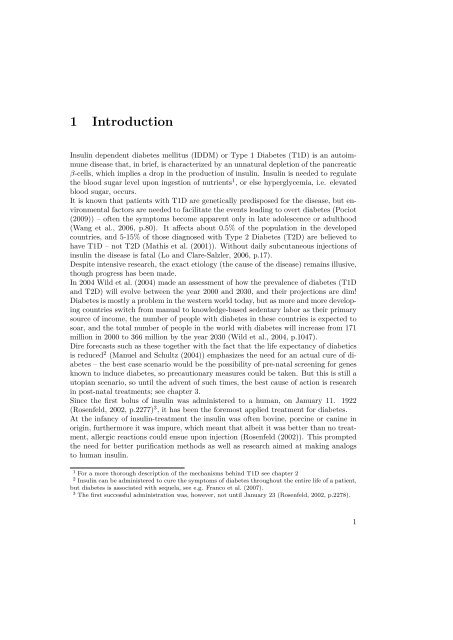nr. 477 - 2011 - Institut for Natur, Systemer og Modeller (NSM)
nr. 477 - 2011 - Institut for Natur, Systemer og Modeller (NSM)
nr. 477 - 2011 - Institut for Natur, Systemer og Modeller (NSM)
Create successful ePaper yourself
Turn your PDF publications into a flip-book with our unique Google optimized e-Paper software.
1 Introduction<br />
Insulin dependent diabetes mellitus (IDDM) or Type 1 Diabetes (T1D) is an autoimmune<br />
disease that, in brief, is characterized by an unnatural depletion of the pancreatic<br />
β-cells, which implies a drop in the production of insulin. Insulin is needed to regulate<br />
the blood sugar level upon ingestion of nutrients 1 , or else hyperglycemia, i.e. elevated<br />
blood sugar, occurs.<br />
It is known that patients with T1D are genetically predisposed <strong>for</strong> the disease, but environmental<br />
factors are needed to facilitate the events leading to overt diabetes (Pociot<br />
(2009)) – often the symptoms become apparent only in late adolescence or adulthood<br />
(Wang et al., 2006, p.80). It affects about 0.5% of the population in the developed<br />
countries, and 5-15% of those diagnosed with Type 2 Diabetes (T2D) are believed to<br />
have T1D – not T2D (Mathis et al. (2001)). Without daily subcutaneous injections of<br />
insulin the disease is fatal (Lo and Clare-Salzler, 2006, p.17).<br />
Despite intensive research, the exact etiol<strong>og</strong>y (the cause of the disease) remains illusive,<br />
though pr<strong>og</strong>ress has been made.<br />
In 2004 Wild et al. (2004) made an assessment of how the prevalence of diabetes (T1D<br />
and T2D) will evolve between the year 2000 and 2030, and their projections are dim!<br />
Diabetes is mostly a problem in the western world today, but as more and more developing<br />
countries switch from manual to knowledge-based sedentary labor as their primary<br />
source of income, the number of people with diabetes in these countries is expected to<br />
soar, and the total number of people in the world with diabetes will increase from 171<br />
million in 2000 to 366 million by the year 2030 (Wild et al., 2004, p.1047).<br />
Dire <strong>for</strong>ecasts such as these t<strong>og</strong>ether with the fact that the life expectancy of diabetics<br />
is reduced 2 (Manuel and Schultz (2004)) emphasizes the need <strong>for</strong> an actual cure of diabetes<br />
– the best case scenario would be the possibility of pre-natal screening <strong>for</strong> genes<br />
known to induce diabetes, so precautionary measures could be taken. But this is still a<br />
utopian scenario, so until the advent of such times, the best cause of action is research<br />
in post-natal treatments; see chapter 3.<br />
Since the first bolus of insulin was administered to a human, on January 11. 1922<br />
(Rosenfeld, 2002, p.2277) 3 , it has been the <strong>for</strong>emost applied treatment <strong>for</strong> diabetes.<br />
At the infancy of insulin-treatment the insulin was often bovine, porcine or canine in<br />
origin, furthermore it was impure, which meant that albeit it was better than no treatment,<br />
allergic reactions could ensue upon injection (Rosenfeld (2002)). This prompted<br />
the need <strong>for</strong> better purification methods as well as research aimed at making anal<strong>og</strong>s<br />
to human insulin.<br />
1 For a more thorough description of the mechanisms behind T1D see chapter 2<br />
2 Insulin can be administered to cure the symptoms of diabetes throughout the entire life of a patient,<br />
but diabetes is associated with sequela, see e.g. Franco et al. (2007).<br />
3 The first successful administration was, however, not until January 23 (Rosenfeld, 2002, p.2278).<br />
1
















